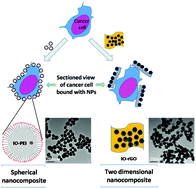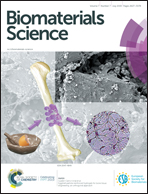Cancer cell–nanomaterial interface: role of geometry and surface charge of nanocomposites in the capture efficiency and cell viability
Abstract
The nanomaterial–cell interface plays an important role in biodetection and therapy. Several parameters involved in the bio–nano interaction such as size, shape, surface charge, surface functionality and protein corona on the nanomaterials have been studied. Recently, we found that the surface charge of the cancer cell membrane derived from the glycolysis could be a general hallmark for cancer cell targeting and very efficient isolation by tailored nanoparticles. However, to simultaneously achieve high capture efficiency and optimal cell viability, the influence of critical features of nanomaterials, such as surface charge and geometry, must be explored. In this study, we designed and synthesized spherical core–shell magnetic particles and Fe3O4 particle coated graphene oxide nanosheets with a similar surface chemistry, charge and magnetization, but different geometries. Although the two-dimensional (2D) graphene oxide based nanocomposites possessed higher capture efficiency at a low working concentration as compared to the spherical nanocomposites, they also exhibited more obvious cytotoxicity. Different aspects of the mechanism underlying the higher cytotoxicity from the 2D nanomaterials were investigated. The results of this study can guide the design of versatile candidates for the isolation of cancer cells.



 Please wait while we load your content...
Please wait while we load your content...